What Is a Frontal Lisp?
Let’s start at the beginning. A frontal lisp, also known as an interdental lisp, occurs when a child says the /s/ and /z/ sounds with the tongue pushed too far forward. This causes /s/ and /z/ to sound more like “th”. Frontal lisps are sometimes caused by tongue thrust, which is when the tongue is consistently too far forward, including during swallowing and at rest (when the tongue is not doing anything at all). Not all frontal lisps are caused by tongue thrust but some are. Tongue thrust requires additional types of therapy that are not discussed in this article. Today’s article will just focus on treatment for a plain old frontal lisp.
Alternatively, there is another type of lisp called a lateral lisp. This is where air comes out the sides of the mouth, making the /s/ and /z/ sounds “slushy”. There is also often a lot of saliva associated with a lateral lisp. For more information about treating lateral lisps, click here.
How Do You Treat Frontal Lisp?
I’m so glad you asked! 🙂 Frontal lisp therapy can be broken down into six steps.
1. Assessment for a Frontal Lisp:
The first thing you will need to do for frontal lisp therapy is to assess the lisp. You don’t need any standardized tests for this, you just need a lot of words for the child to say so you can see if there are any words where the child is already producing a good /s/ or /z/ sound. I recommend you test both the /s/ and /z/ in all word positions. This means testing when the sound is at the beginning, middle, and end of the word as well as in consonant clusters (blends) at both the beginning and end of the word.
Simply have the child say words with the sounds in all of those different positions. If the child can read, just have him read word lists. If the child cannot read, you can have him label pictures that represent the words. Below are my word lists for /s/ and /z/ in all positions, or you can download my articulation cards which contain pictures of /s/ and /z/ words in the initial, medial, and final position as well as /s/ blends in the initial position of words. Just write down which words the child can say correctly and which words are lisped.
Lisp Words: Word Lists for Assessing Frontal Lisps
Initial /s/
- Say
- See
- Siren
- Soap
- Soup
- Second
- Simple
- Sock
- Sad
- Soot
- Sun
- Sound
- Soy
Medial /s/
- Medicine
- Motorcycle
- Pieces
- Pacifier
- Castle
- Whistle
- Dinosaur
- Glasses
- Recycle
- Pencil
- Baseball
- Popsicle
Final /s/
- Base
- Crease
- Ice
- Close (like opposite of far)
- Moose
- “s”
- Kiss
- Boss
- Class
- Bus
- Mouse
Initial /s/ Blends
- Smile
- Smell
- Small
- Smooth
- Swing
- Sweet
- Swim
- Snake
- Snow
- Snack
- Sticker
- Stop
- Stairs
- Spoon
- Spaghetti
- Spider
- Strawberry
- Street
- stripe
Final /s/ Blends
- Coughs
- Laughs
- Forests
- Tests
- Claps
- Tips
- Wasps
- Asps
- Fox
- Mix
- Mask
- Whisk
- Asks
- Whisks
- Best
- Lost
Initial /z/
- Zebra
- Zoo
- Zipper
- Zap
- Zero
- Zig zag
- Zone
Medial /z/
- Puzzle
- Scissors
- Bulldozer
- Lizard
- Wizard
- Raisin
- Tweezer
- Desert
- Present
- Newspaper
Final /z/
- Maze
- Sneeze
- Eyes
- Nose
- Lose
- Fizz
- Jaws
- Fuzz
- Cows
- Boys
2) Find a Natural Tongue Placement to Eliminate Frontal Lisp
Ok, take a look at your results. Was the child able to say the /s/ or /z/ sound correctly in any of those words? If so, that’s where you’re going to start! Have the child say that word (or words if the child had multiple words he could say) and ask him to feel where his tongue is for the /s/ sound when he says it. Talk about how the tongue is behind the teeth. Ask the child to tell you if his tongue tip is up or down. Either way is acceptable and some children do it with the tongue tip up behind the top front teeth and some do it with the tongue tip down behind the bottom front teeth.
Make sure the child is saying the /s/ sound in the word in a very crisp, clear manner without any lisp. If he starts to lisp on it, try a different word. Practice this correct /s/ sound (in those words if necessary) until the child knows exactly what his tongue is doing. If the child does not have any correct productions after testing all of those words, you can either keep trying new words to try to find a good one, or try some elicitation techniques to get an /s/ without having a word that he can already produce correctly.
Elicitation Techniques for /s/ and /z/:
If the client is having a hard time getting a good /s/ placement, try some of these tips. Watch the video below for tips for speech-language pathologists to help a child produce this sound.
Exploding /t/ Sound:
Start by having the child say the /t/ sound. Have him say it over and over again (“t…t…t..t…t”). Then, tell him that you want him to say it 5 times but explode the last one. Take that last /t/ and force it out as hard and long as you can. It should sound like this “t…t…t…t…tsssss”. You should get a nice /s/ sound after the /t/. Don’t tell the child that’s the /s/ sound right away.
Practice it a few times until you know he can do it and then say “Hey, that makes an /s/ sound at the end”. If you can get the exploding “t” sound, then you can practice it in words that end in “ts” like “bets” and “cats”. Or, you can practice holding out the /s/ part of it and then putting a pause in the middle of the /s/ so that the child gets practice starting the /s/ sound again, like “tssss…sssss”.
The Straw Technique for Teaching the /s/ Sound:
This is a great strategy for teaching the /s/ sound. Use a straw to get help the child keep their tongue back and blow the air right through the middle.
Coarticulation:
Coarticulation is when you put a different sound next to the target sound so it comes out more clearly. In the above example, we used the /t/ to facilitate the /s/ sound because the /t/ sound is produced in the same place in the mouth as the /s/ sound. You can use coarticulation by saying a word that ends in /t/ right before a word that starts with /s/.
For example, you could say “cat soup” to try to get a good placement for /s/. You could also use the /n/ sound, like “tan silo” because the /n/ sound is also produced in the same place as the /s/. Or, you may find that other sounds work well to help the child say the /s/ or /z/ sound, such as sounds that require the tongue to be in the back of the mouth like /r/ (bear soup) or /k/ (black sock). Try a bunch of different sounds to see if any help.
Turning Voice on for /z/:
If you are able to get the /s/ sound but are struggling to get /z/, have the child practice turning his voice on by humming. Have the child place his hand on his throat so he can feel the vibrations when he turns his voice on and hums. Then, have him say the /s/ sound and then turn his voice on or hum. If he’s having trouble with this, have him hum a simple tune while saying the /s/ sound.
3. Eliminate Frontal Lisp in Single Words
Once you are able to get the child to say a good /s/ or /z/ sound (either in single words or by itself), you want to start working on saying that sound in single words. If you were able to get the child to say either /s/ or /z/ in one or more of the words from the assessment, start with those words and other words like them. For example, if the child was able to say “bus”, try other words that have the “uh” vowel and then the /s/ sound, like “us”, “Gus”, “Rus” (you may have to get creative). Then, slowly branch out to words that are slightly less similar. For this example, you could start trying other words with /s/ at the end but with different vowels.
If you weren’t able to get any of the words before but were able to get a good /s/ using the elicitation techniques, try having him put that good /s/ into some words and see what’s the easiest. For example, if you used the exploding /t/, you’ll want to start with words that have /ts/ in them. If you need to, go through the list again and see if any words are easier now that the child has a good /s/ in isolation. Then, start with those words.
Gradually shift to other words that are similar. Once you pick where to start, focus on just that sound in just that position. For example, if you start with “bus”, you should only work on /s/ at the ends of words until the child can do that one well. Or, if you choose “best” to start with, you should only use /st/ at the ends of words until the child has mastered it.
4. Practice that Sound/Position in Sentences
Once the child can say that one sound in that one position or context, practice saying those words in sentences. You can have the child repeat simple sentences that you say or make up his own sentences. Just make sure that he’s really mastered that sound in that position before you move on.
5. Go Back and Do It Again: Eliminate Frontal Lisp in a New Position
Now that the child has mastered that sound in that position in sentences, you’ll want to go back and pick a new target to practice in single words again. You’ll want to do another mini assessment because some of the other /s/ or /z/ words may have fixed themselves while you were working on that one context. From your quick re-assessment, look for words that are getting close but aren’t quite there. Or, choose a position that’s similar to what you already worked on.
I would stick with the same sound you chose to work on first instead of switching back and forth between /s/ and /z/. Just pick a new position (like /s/ at the beginning of words or /s/ in /st/ initial blends) and practice it in single words and then sentences. Keep repeating this process until the child can produce the /s/ or /z/ sound in sentences in any position or context. At this point, you can either repeat the process for the other sound or move on to conversational carry-over with the first sound.
6. Eliminate Frontal Lisp and Interdental Lisp in Conversation
Once the child is able to say the sound in sentences, you’ll want to work on the sound in conversation. For more information on practicing sounds in conversation, check out my post on increasing self-awareness and carry-over: Click Here to Learn About Teaching Sounds in Conversation
Voila!
There you go! All the steps to doing speech therapy for frontal lisps/interdental lisps. I hope you found that information helpful. Don’t forget to download the /s/ and /z/ articulation cards below.
Additional Resources for Lisp Speech Therapy:

About the Author: Carrie Clark, MA CCC-SLP
Hi, I’m Carrie! I’m a speech-language pathologist from Columbia, Missouri, USA. I’ve worked with children and teenagers of all ages in schools, preschools, and even my own private practice. I love digging through the research on speech and language topics and breaking it down into step-by-step plans for my followers.
Fun Fact: In college, I did a brief stent as the secretary of the Herpetology club….which in case you were wondering is all the creepy crawly reptiles and amphibians like snakes, lizards, frogs, etc. Can’t say I had more than a passing interest in those things but my friend was in the club and there were only 5 members so I got drafted into a leadership position.
Connect with Me:
Podcast: Play in new window | Download | Embed
Subscribe: Apple Podcasts | RSS

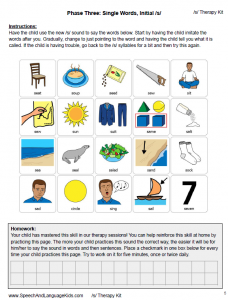
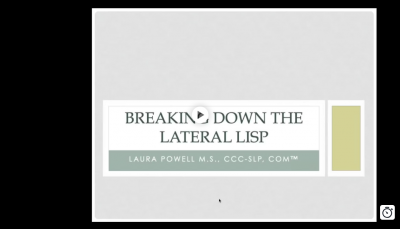
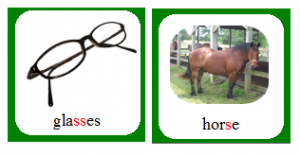
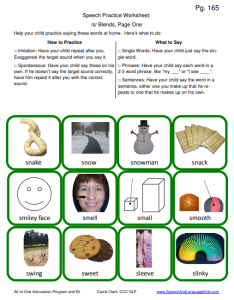
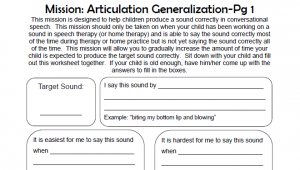





Hi Carrie, thank you so much for this episode. I’m a SLPA just graduating and i find your episodes very useful. specially if you havent got the opportunity to work with a client who has a lisp during your placement.
Thanks again.
You are very welcome! These are all of the materials that I wish I had during my internships and CFY! Enjoy!!
Hi Carrie,
I loved your blog about this topic. I’ve been waiting for a while for you to make a blog like this. Very helpful! I’d love to hear a blog about the lateral lisp as well if you ever decide to podcast about that. I’m sure we all could learn more! I hope you make one about it! Thanks!
I have a post on lateral lisps, but it doesn’t have the audio version. You can read it though, here:
Lateral Lisp Case Study:
http://www.speechandlanguagekids.com/speech-therapy-lateral-lisp-case-study/
Hi Carrie!
Love the this podcast! How young should a child be to begin treatment for frontal lisp?
Wonderful! Thank you! I think the age you start depends a lot on the child. I have a 4-year-old that I’m working on frontal lisp with right now but I probably wouldn’t start that young for most children. For this little guy though, all of his siblings still have frontal lisp errors at an older age so he is at a greater risk for not fixing it on his own. Also, he’s very receptive to therapy and wants to improve it. That being said, many preschoolers have a frontal lisp and it goes away on its own, so I probably wouldn’t start on frontal lisp with all preschoolers. However, once they are in school, probably by first grade, I would say it’s definitely time to get started. Hope that helps!
This page is a God-send! I have an 8 (almost 9) year old girl with a lateral lisp (seems to talk from left side of her mouth a lot) and a 4 yr old boy with a severe (in my opinion, although he is young still) frontal lisp. My 8 year old is motivated to correct the issue because she is passionate about performing vocally and on stage. She will engage with exercises with me…my 4 year old begins to shut down with any form of correction, even something fun and engaging like your mirror activity with the snake. Because he has an older sibling with a lisp would you recommend I become more intentional with correct his issue now, possibly enrolling him in therapy? *I have a 6 year old daughter with no speech issues and an almost 2 year old (but the verdict is out on her still right? 😉
You’re officially my favorite SLP blogger. I’m loving this! Thank you!
Awesome, thank you!! I’d love for you to share the site with your speech therapist friends. It really helps spread the word!!
hi carrie, i have an 11 year old boy who has a frontal lisp. we have never had him do any speech therapy and am now worried it is late to help him correct this. someone asked me to see if he could curl the sides of his tongue up into a tube which he can not do . what do you think about that?
Hi! I have never heard of curling the tongue to be a test for ability to fix a frontal lisp. It is absolutely not too late but you would be wise to go ahead and seek the help of a speech therapist as soon as possible!
Enjoyed this info. What I’m really after is information on remediation of lateral /sh/ which I have been having a beast of a time with! Tried everything from PROMPT, to teaching the “butterfly” position, to oral stimulation for improved placement…I’m at my wits end! Any suggestions would be greatly appreciated!
Try this post:
Lateral Lisp Case Study:
http://www.speechandlanguagekids.com/speech-therapy-lateral-lisp-case-study/
What an awesome podcast! Very helpful. I have tried to look for such information on the net earlier and couldn’t find and so i very much appreciate this. Thank you Carrie!
Oh good! I’m so glad I was able to help!!
Hi Carrie,
Thanks for the helpful tips. Have you ever done this with a kid missing his two front teeth? While his frontal lisp is no longer as noticeable, I can still tell that his tongue is not at his alveolar ridge during productions because of the space. I’m afraif that even though his tongue is in his mouth now, he’s still pushing foward. Also, his lower jaw has started to protrudce foward when he’s workign hard to make the /s/ sound despite making him aware of this visually and verbally. I’m stuck! Any thoughts?
Emily
Hey there! I think you could still do some work on keeping the tongue back until the front teeth emerge, but you’re obviously not going to know if the problem is fixed permanently until you can work on it with those teeth in place. As for the jaw, I haven’t experienced that one myself so I’m not sure what to recommend. I would guess that increasing awareness would definitely help and sometimes kids just need to take a break from a sound if they start doing something maladaptive because they’re trying so hard!
My almost 5 year old son had trouble with a number of sounds but never qualified for speech therapy. I have used this site to help me teach him the sounds myself and find it extremely helpful. Our most recent work is on his very pronounced lateral lisp. Thank you for the great tips!
Oh good!! I’m so glad that this site was helpful to you! It’s a shame that more children can’t qualify for the services when they need them!
Hi from Ireland. I love your youtube video about frontal lisp with s sound. I have a 4 year old boy that has this pronunciation difference and he already started having social issues. I found your channel/ website looking for solution. How loung should i exercise with him daily? 10 min? 5? 30? Awesome information. Thank you very much for your work.
Generally, I recommend that families practice for shorter sessions, more frequently. 5 minutes twice a day is a good place to start and then you can tweak from there!
This article is great! Thanks for it, My mainly could not pronounce “R”, “H”,”Q” etc could you please help me on how to get that improve?
For the /t, t, t, t, tssss/ tip I use a visual of a slide. They can tap the rungs of each ladder as they say /t/ and then “go down the slide” with their finger as they prolong that /s/ sound
Thank you for the article. My daughter has been lisping since she started speaking. She is now 10. She is an identical twin and her sister does not lisp. I had therapy for lisping through school and I’m much better but I still catch myself periodically. Her teacher says she hasn’t noticed it. Though, she has only been in her class for a couple of weeks. Frankly though, I’m surprised she didn’t notice without being told. I’m worried that at this age she will have a hard time correcting it. I started speech therapy in 2nd grade but every year when I ask about it I’m told it will get better as she gets older.
THANK YOU so much for the information! My daughter had an expander and braces and now has a mild frontal lisp I would like to work on with her. I love that you have resources available for everyone. I asked the speech therapist at the school for some tips on how to work with daughter, and I was just referred me to my school speech therapist. Not so helpful. So thank you for this resource!
My son is 2 years 3 months old. He’s very intelligent and is quick in grasping new words and speaks a lot but he has a frontal lisp while pronouncing any word with the ‘s’ sound. Will this problem subside on its own or does it require visiting a speech therapist?
This is such a valuable resource. Thank you so much for your professional advice. I am thrilled to have your input to assist with my work with older children.
Great article !!! loved it! thank you
one of My student has a frontal lisp and he also has missing bottom teeth how do you address this?
I have a student who is 10 years, 8 months old. I started with her in preschool because she had multiple phonological processes. We cleaned those up and then I fixed her /w/ for prevocalic /r/ substitution and vocalic /r/ distortion. Her mom asked me to start speech therapy up with her again but gave the caveat that she will be getting an upper expander in a month. Would you still work with her on /s/ and /z/ after getting the upper expander?
Great, very helpful.
Now, of course, mirror is pronounced me-ror, not me-er. 🙂
My parents attempted to fix my severe fontal lisp when I was younger but I wasn’t motivated and had no initiative to deal with it. Now as a 17-year–old going into Law School with a mild frontal lisp I decided to pony up and correct my speech. This video in particular has been amazing and already done wonders. In your experience, how long has the daily practice and routine of pronunciation taken for a child to fully correct their lisp and have perfect speech?
Hi, Henry-
Each person has their own timing as to when the lisp will correct. We cannot give a definitive answer to that. However, we did want to acknowledge you and let you know we are happy to see that our resources have been of help to you!
Hey there!
Is speech therapy always effective for a lisp? I have 2 students who have goals specifically for using /s/ and /sh/ in structured and unstructured conversation.. still no progress outside of my speech room. This has been about a year of pulling them out of class two times a week with no generalization occurring in their conversation whatsoever. They both have mastered the skill up to sentence level, but are still having a hard time breaking their lisp habit. When not looking at them, their lisp sounds VERY close to an actual /s/ production. Just wondering if sometimes, even with regular speech therapy, they may just always have a lisp.
Thanks 🙂
Hello! Thank you so much for reaching out. Unfortunately, we get a ton of questions every day about how to solve specific speech/language problems. Since we have such a small staff, we aren’t able to answer every question that comes through on the website, social media, or via email. If you are a parent, we suggest you reach out to a local speech-language pathologist who can work with your child directly and answer your question.
If you are another speech-language professional, we have created a membership where we pay a full staff to answer questions like this on a regular basis. We would be more than happy to answer your question inside the membership program. We’re able to answer more questions in here because we have a full library of questions that we’ve already answered so our staff can either link you to the answer if it exists, or write you a custom response if needed. We’d love to see you inside the membership!
Click Here to Become a Member: https://www.slpsolution.com/pediatric-signup/.
Thank you so much for this. I’m going to start working with my six year old tonight. She loves word games, so I think she will actually enjoy this! Really enjoyed the video and the article.
That’s great, Marisa! Please let us know if you need anything else. We are here to help!
I am so grateful for this blog. I have a 6.5 year old I would like to start working with. I was hoping it would fix on its own but I do not see any progress. How often do you recommend I start these exercises and for how long??
Hello, Connie!
Thank you so much for reaching out. Unfortunately, we get a ton of questions every day about how to solve specific speech/language problems. Since we have such a small staff, we aren’t able to answer every question that comes through on the website, social media, or via email. If you are a parent, we suggest you reach out to a local speech-language pathologist who can work with your child directly and answer your question.
If you are another speech-language professional, we have created a membership where we pay a full staff to answer questions like this on a regular basis. We would be more than happy to answer your question inside the membership program. We’re able to answer more questions in here because we have a full library of questions that we’ve already answered so our staff can either link you to the answer if it exists, or write you a custom response if needed. We’d love to see you inside the membership!
Click Here to Become a Member: https://www.slpsolution.com/pediatric-signup/.
Hey i have lisps specially in those words which is end with s amd i am 25 years old can i speak clear s now .can i get rid off this lisps please rly.
Hello, Vaishali!
Thank you so much for reaching out. Unfortunately, we get a ton of questions every day about how to solve specific speech/language problems. Since we have such a small staff, we aren’t able to answer every question that comes through on the website, social media, or via email. If you are a parent, we suggest you reach out to a local speech-language pathologist who can work with your child directly and answer your question.
If you are another speech-language professional, we have created a membership where we pay a full staff to answer questions like this on a regular basis. We would be more than happy to answer your question inside the membership program. We’re able to answer more questions in here because we have a full library of questions that we’ve already answered so our staff can either link you to the answer if it exists, or write you a custom response if needed. We’d love to see you inside the membership!
Click Here to Become a Member: https://www.slpsolution.com/pediatric-signup/
Thank you so much. I had a strong frontal lisp as a child but at around the age of 7, I’ve been told, I just stopped without any speech therapy. I’m now an opera singer however I have had many issues with tongue tension which I have attributed to the way I adapted my lisp as a child. Having studied with member of the British voice association I have been deeply fascinated with the use of speech therapy methods in my practice and teaching.
Having gone back to experiment with speaking with “th” tongue potion and doing the exercises I have really discovered such a lot in how I have managed to produce “ss” sounds. I have done this with the sides/middle of the tongue which I think has been a major contributing factor to the TRT. Thank you so much.
GS Pritchard
i love it when i practice this at home i am 11 and this is helping me out alllot without tis my lisp would just get worse and worse. thankyou!!!!!!!!!!!!!!
You are more than welcome, Dominick! Keep up the good work and know we are here to help!
THANKYOU!!!!!!!!!!!!!!!!!!!!!!!!!!!!!!!!!!!!!!!!!!!!!!!!!!!!!!!!!!!!!!
Thanks for sharing the elicitation tips and videos! I love being able to watch a strategy to learn how to use it.